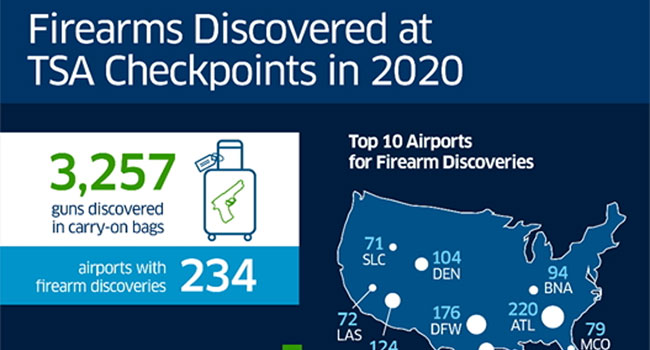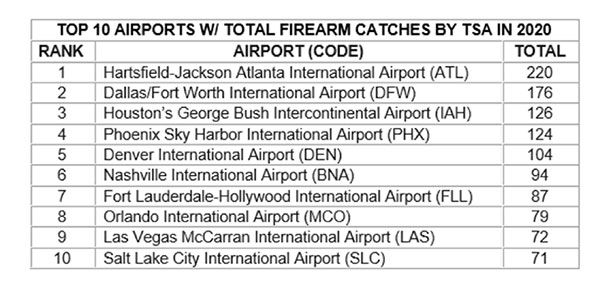
Airport Firearm Detection more than Doubles in 2020
Transportation Security Administration (TSA) officers detected twice as many firearms per million passengers screened at airport security checkpoints nationwide in 2020 compared to 2019, and at a significantly higher rate than any other year since the agency’s inception. Throughout 2020, TSA caught approximately 10 firearms per million passengers screened as compared to about 5 firearms per million passengers screened in 2019.
TSA officers discovered a total of 3,257 firearms on passengers or in their carry-on bags at checkpoints, although total passengers screened in 2020 fell by 500 million versus 2019 due to the pandemic. Of those firearms caught in 2020, about 83 percent were loaded. In 2019, TSA officers stopped a record 4,432 firearms, of which 87 percent were loaded.
“I commend our officers for their commitment to TSA’s security mission by identifying and stopping these weapons at the TSA checkpoints. Firearms are strictly prohibited onboard planes in the passenger cabin,” said Darby LaJoye, TSA Administrator, senior official performing the duties. “Bringing a firearm to a TSA security checkpoint poses a serious risk to TSA officer and passenger safety, and doing so may result in significant fines or arrest.”
Passengers with firearms at checkpoints were stopped at 234 airports nationwide. The top ten airports where TSA officers detected guns at checkpoints in 2020 were:

Airline passengers can fly with firearms in checked baggage if the firearms are properly packed and declared at check-in. However, firearm possession laws vary by state and locality. TSA advises travelers to familiarize themselves with state and local firearm laws for each point of travel prior to departure to ensure they transport guns in accordance with applicable laws.
Airlines may have additional requirements for traveling with firearms and ammunition, so travelers should also contact the airline regarding firearm and ammunition carriage policies prior to arriving at the airport.
In some cities, local law enforcement may file criminal charges against travelers who bring firearms to the TSA checkpoint. TSA will assess civil penalties that vary by number of previous offenses and whether the firearm was loaded at the time.
The complete list of penalties is posted on TSA.gov. Firearms are not permitted in the passenger cabin of an airplane; this includes travelers with a concealed weapon permit.
Where local firearm possession laws permit, passengers may travel with firearms in checked baggage if they are unloaded and packed in a locked hard-sided case. Ammunition must be in its original box and can be packed inside the hard-side case, next to the firearm. Even if the box of ammunition is not full, the bullets must be in their original case. The passenger must present the case with the firearm at the airline check-in counter and inform the airline representative of their intention to travel with the gun.
Firearms are transported with checked baggage and are placed in the cargo hold of the aircraft.
Data collected represents the number of firearms caught on passengers and in their carry-on bags at the nation’s TSA checkpoints. Excluded from the data are improperly packed guns at checked baggage stations, toys, replicas and BB guns. Visit the TSA website for details on how to properly travel with a firearm.